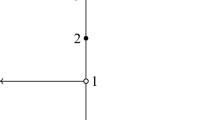Abstract
We consider a general class of equilibrium problems which involve a single-valued mapping and a nonsmooth bifunction. Such mixed equilibrium problems are solved with a combined relaxation method using an auxiliary iteration of a splitting-type method for constructing a separating hyperplane. We prove the convergence of the method under the assumption that the dual of the mixed equilibrium problem is solvable. Convergence rates are also derived.
Similar content being viewed by others
References
P.L. Lions B. Mercier (1979) ArticleTitleSplitting Algorithms for the Sum of Two Monotone Operators SIAM Journal of Numerical Analysis 16 964–979 Occurrence Handle10.1137/0716071
J. Eckstein D. P. Bertsekas (1992) ArticleTitleOn the Douglas-Rachford Splitting Method and the Proximal-Point Algorithm for Maximal Monotone Operators Mathematical Programming 55 293–318 Occurrence Handle10.1007/BF01581204
M. Patriksson (1999) Nonlinear Programming and Variational Inequality Problems: A Unified Approach Kluwer Academic Publishers Dordrecht Netherlands
P. D. Panagiotopoulos (1985) Inequality Problems in Mechanics and Their Applications Birkhäuser Massachusetts Boston
I. V. Konnov S. Schaible (2000) ArticleTitleDuality for Equilibrium Problems under Generalized Monotonicity Journal of Optimization Theory and Applications 104 395–408 Occurrence Handle10.1023/A:1004665830923
I. V. Konnov (2001) Combined Relaxation Methods for Variational Inequalities Springer Verlag Berlin
I. V. Konnov (1993) ArticleTitleCombined Relaxation Methods for Finding Equilibrium Points and Solving Related Problems Russian Mathematics (Iz. VUZ) 37 44–51
N. Xiu J. Zhang (2003) ArticleTitleSome Recent Advances in Projection-Type Methods for Variational Inequalities Journal of Computational and Applied Mathematics 152 559–585 Occurrence Handle10.1016/S0377-0427(02)00730-6
I. V. Konnov (1999) ArticleTitleA Combined Method for Variational Inequalities with Monotone Operators Computational Mathematics and Mathematical Physics 39 1051–1056
I. V. Konnov (2003) ArticleTitleApplication of the Proximal-Point Method to Nonmonotone Equilibrium Problems Journal of Optimization Theory and Applications 119 317–333 Occurrence Handle10.1023/B:JOTA.0000005448.12716.24
C. Baiocchi A. Capelo (1984) Variational and Quasivariational Inequalities: Applications to Free Boundary Problems John Wiley and Sons New York, NY
B. T. Polyak (1987) Introduction to Optimization Nauka, Moscow, USSR, 1983 English Translation in Optimization Software New York, NY
M. C. Ferris (1991) ArticleTitleFinite Termination of the Proximal-Point Algorithm Mathematical Programming 50 359–366 Occurrence Handle10.1007/BF01594944
Author information
Authors and Affiliations
Additional information
S. Schaible - This author gratefully acknowledges partial support from the National Science Council of Taiwan.
J.C. Yao - His research was partially supported by Grant NSC 93-2115-M-110-011
Rights and permissions
About this article
Cite this article
Konnov, I.V., Schaible, S. & Yao, J.C. Combined Relaxation Method for Mixed Equilibrium Problems. J Optim Theory Appl 126, 309–322 (2005). https://doi.org/10.1007/s10957-005-4716-0
Issue Date:
DOI: https://doi.org/10.1007/s10957-005-4716-0



